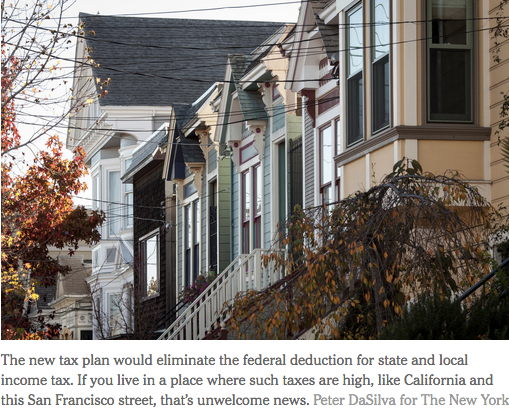The tax plan the Trump administration released Wednesday consists (so far) of a single page of bullet points.
If this were a more rounded plan, we could wait for the tax wonks at various think tanks to run it through their models and tell with some precision how it would affect people at different income levels and who would benefit from different deductions.
Lacking that level of detail, we can know only in broad-brush strokes which Americans would win and which would lose. In a homage to the Trump plan itself, here are those winners and losers in bulleted form.
Breakdown Of the Plan, In 7 Pieces
Mr. Trump’s Comic Tax Plan
As a rule, Republican presidents like offering tax cuts, and President Trump is no different. But the skimpy one-page tax proposal his administration released on Wednesday is, by any historical standard, a laughable stunt by a gang of plutocrats looking to enrich themselves at the expense of the country’s future.
Two of Mr. Trump’s top lieutenants — Steven Mnuchin and Gary Cohn, both multimillionaires and former Goldman Sachs bankers — trotted out a plan that would slash taxes for businesses and wealthy families, including Mr. Trump’s, in the vague hope of propelling economic growth. So as to not seem completely venal, they served up a few goodies for the average wage-earning family, among them fewer and lower tax brackets and a higher standard deduction.
This Isn’t Tax Policy; It’s a Heist
But the heart of Trump’s “plan” is to lower taxes for corporations and the affluent. It would eliminate the alternative minimum tax, without which Trump would have paid less than 4 percent in taxes for 2005; with it, he paid 25 percent.
Conservatives emphasize that the official top corporate tax rate in the U.S. is too high, and they have a point. The top rate for American corporations — almost 39 percent, including a 35 percent federal rate and a bit more for the average state rate — is among the highest in the world, according to the Tax Foundation.
Yet that’s deeply misleading, because most companies don’t pay that rate. The Government Accountability Office found that two-thirds of active corporations paid no federal tax. Even large, profitable corporations paid an average federal rate of only 14 percent — and Boeing, Verizon, General Electric and Priceline paid no federal income tax over a five-year period, according to Citizens for Tax Justice.
Trump Tax Plan Would Shift Trillions From U.S. Coffers to the Richest
WASHINGTON — President Trump’s proposal to slash individual and business taxes and erase a surtax that funds the Affordable Care Act would amount to a multitrillion-dollar shift from federal coffers to America’s richest families and their heirs, setting up a politically fraught battle over how best to use the government’s already strained resources.
The outline that Mr. Trump offered on Wednesday — less a tax overhaul plan than a list of costly cuts with no price tags attached, rushed out by a president staring down his 100-day mark in office — calls for tax reductions for individuals of every income level as well as businesses large and small.
But the vast majority of benefits would accrue to the highest earners and largest holders of wealth, according to economists and analysts, accounting for a lopsided portion of the proposal’s costs.
“The only Americans who are very clear winners under the new system are the wealthiest,” said Edward D. Kleinbard, a law professor at the University of Southern California and former chief of staff of Congress’s Joint Committee on Taxation, which estimates the revenue effects of tax proposals.




